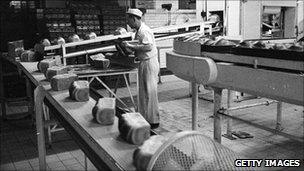Chorleywood: The bread that changed Britain
- Published
- comments

For the past 50 years, a British food stuff has spread across the world to Australia, South Africa, South America, Turkey and even to supermarket shelves in France. But is the long life, plastic wrapped, sandwich loaf that was first created in Chorleywood a design classic or a crime against bread, asks David Sillito.
More than 80% of all loaves in Britain are now made the Chorleywood way.
Even the fresh crusty bread baked at your local supermarket is probably made the Chorleywood way.
The work of the scientists at the Chorleywood Flour Milling and Bakery Research Association laboratories in 1961 led to a new way of producing bread, making the average loaf in Britain 40% softer, reducing its cost and more than doubling its life.

The move was good for British farmers growing low-protein wheat
What is more, each slice was uniform.
For its supporters, it was the innovation that pushed bread into the modern era.
"It is a process we invented and we should be very proud of it," says Gordon Polson, of the British Federation of Bakers. "UK bread is around the cheapest in the world."
The bread scientist, Stan Cauvain, who worked with the original inventors and has written the definitive work on the Chorleywood Process says they knew from the beginning they had changed baking forever.
"The inventors knew they were on to something special and it would have far reaching consequences."
Its origins lay in the late 1950s and the need to try to find a way for small bakers to compete with new industrial bakeries. The light brown "national loaf" during the long years of rationing had, for many consumers, outstayed its welcome. Soft, springy, white bread - that did not go stale quickly - was what the public wanted.
The research bakers at Chorleywood discovered that by adding hard fats, extra yeast and a number of chemicals and then mixing at high speed you got a dough that was ready to bake in a fraction of the time it normally took.
It allowed bread to be made easily and economically with low protein British wheat.
But with industrial bakers quickly adopting the process, rather than helping small bakeries, the research at Chorleywood helped put thousands of them out of business.
But for some bread lovers, particularly the "artisan bread movement" anything Chorleywood is simply not real bread.
"This stuff is like cotton wool," says Paul Barker, who himself used to work as an industrial baker and sold the emulsifiers, enzymes and other chemicals used in modern baking.
The classic white loaf - how it is made and what people think of it
He has now set up Cinnamon Square in Rickmansworth, a "theatre of baking" aimed at reinvigorating the old way of making bread.
The issue he says is about both taste and digestion. "Modern bread doesn't taste of bread," he says. "If it's not allowed to rise and prove naturally then it doesn't develop the proper taste."
There is also the matter of health. The Chorleywood loaf has twice the amount of yeast of a traditional loaf, it has enzymes and oxidants added and while certain chemical additives such as potassium bromate have been banned, Paul Barker and other bread campaigners believe it is behind the growth in the number of people who struggle to digest bread.
"Every day I have people who say they have given up eating bread and then find they don't have a problem with bread that's been allowed to develop slowly. My sourdough takes more than 70 hours to make."
Proving this, however, is another matter. Prof John Warner at Imperial College in London says there has been a marked increase in allergies and intolerance of wheat and bread over the last 50 years, just as there has been an increase in allergies to dust, nuts and dozens of other items.
However, three-quarters of people who believe they have an allergy or medical intolerance to bread show no signs of any symptoms in blind testing.
He, himself, though is wary of what sort of bread he eats. "We have several pounds of bacteria in our guts and there have been marked changes in this gut flora in affluent societies over the last 50 years."
Prof Warner says he would always choose the simpler product.
And while producers are not obliged to say what enzymes are added to the bread, Polson says there is no evidence that it is any harder to digest.
"There are some additional additives to give it a bit more shelf life, a bit of extra softness - but all it's doing is augmenting what is happening in the natural process."
So, the Chorleywood process has its critics but its success with consumers is undeniable.
Even in France some stick loaves are now made the Chorleywood way, although not the classic "baguette".
The process is now used in more than 30 countries with Colombia and Ecuador taking it on in the last few years. Britain's white bread market is worth about £1bn a year, and most of that is Chorleywood bread.
It's cheap, filling, soft, long-lasting and, because it can turn low-protein British wheat in to palatable bread, a boon to British farmers.
But while it's considered by researchers at the food technology research institute in Chipping Campden to be a marvel of food engineering - the public does not seem to value it too highly.
Almost a third of the bread bought in Britain - 680,000 tonnes a year - is thrown away.